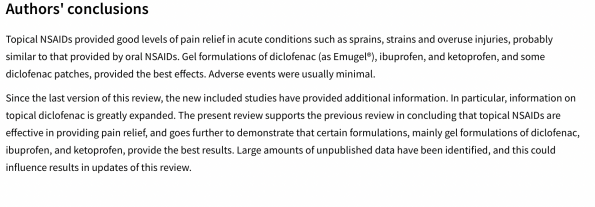I was early in my PGY-1 year when I first witnessed an adverse effect from oral nonsteroidal anti-inflammatory drugs (NSAIDs). It was a busy morning with long patient wait times, and I picked up the chart of a 19-year-old female presenting with abdominal pain. She told me that she had severe abdominal pain overnight, and it had worsened since then. She had no past medical history, was not on any prescription medications, and her vital signs were normal. When I examined her, I found her diffusely tender. All her bloodwork, including a Beta-HCG, was normal. I was early in my training, and I wasn’t sure what was causing her pain.
When I returned to examine the patient with the attending physician, it became clear what the cause of the patient’s pain was. The patient revealed that she had been using Ibuprofen for the past two weeks as she had been exercising more regularly. She was ultimately diagnosed with a perforated peptic ulcer due to oral NSAID use. This was a healthy person whose life was completely changed by her use of oral anti-inflammatories.
As ED physicians, we regularly recommend the use of oral NSAIDs to our patients. In fact, during a typical shift, it’s likely that you advise every second or third patient to take an NSAID. NSAIDs account for 8% of prescriptions worldwide.(1,2)
NSAIDs work by inhibiting cyclooxygenase (COX) enzymes, which are involved in the production of prostaglandins, molecules that play a crucial role in the inflammatory response. Oral formulations include medications such as ibuprofen and naproxen. The mechanism of action of NSAIDs is well understood, and they are highly effective in treating many types of pain.(3) However, their use comes with the risk of gastrointestinal, cardiac, and renal side effects. This article explores the role of topical NSAIDS in the ED, and their potential to minimize oral NSAID use, and mitigate their potential harms.
Risks of Oral Anti-Inflammatories
Despite their effectiveness, oral NSAIDs come with the risk of side effects to multiple organ systems.
The most well-known adverse effect of oral NSAIDs is gastrointestinal (GI) side effects. High-quality studies show that oral NSAIDs lead to GI effects such as abdominal pain, nausea, vomiting, diarrhea, constipation, and heartburn.(1,4) Moreover, one-third of patients taking NSAIDs develop these symptoms, as well as some serious GI adverse effects like GI ulcer, GI bleeding, perforation. Patients taking oral NSAIDs are 4 times more likely to have GI bleeding or perforation compared to someone who is not on NSAIDs.(5) This is why most physicians counsel their patients about the risks of oral NSAIDs.
In addition to GI side effects, oral NSAIDs have been linked to cardiac adverse effects. A meta-analysis of 754 randomized controlled trials (about 350,000 patients) has shown that NSAIDs increase the risk of heart failure, myocardial infarction, stroke, and ultimately all-cause mortality.(6) Oral NSAIDs have a dose-dependent and time-dependent effect on the risk of adverse events, which means that higher doses and longer exposures lead to higher chances of gastrointestinal and cardiac adverse effects.
Oral NSAIDs are also associated with adverse renal effects. These include acute kidney injury (AKI), hypertension, fluid and electrolyte disorders, and chronic kidney disease.
Starting oral NSAIDS in a patient over the age of 65 immediately doubles their risk of AKI in the next 30 days.(5,7) Beyond the ‘Big Three’ adverse effects of oral NSAIDs, these medications have numerous additional risks. NSAIDS can cause hepatic toxicity, hematologic issues including platelets dysfunction, and anaphylactoid reactions. The risk of all these adverse reactions increases with higher doses of NSAIDs, and the longer a patient is taking them.(5)
These risks are often on our minds, and we discuss them with our patients whenever we prescribe a course of oral NSAIDs.
The Role of Topical NSAIDs
Given the risks associated with oral NSAIDs, physicians are increasingly turning to alternative methods of pain management. One such method is topical NSAIDs. Topical NSAIDs are available as gels, creams, lotions, sprays, and patches. They work by penetrating the skin and exerting their anti-inflammatory and analgesic effects directly at the site of pain, without the need for systemic absorption. This means that topical NSAIDs have a lower risk of systemic side effects than oral NSAIDs.
Several studies have demonstrated the benefits of topical NSAIDs. A 2017 Cochrane review analyzed 206 studies with a total 30 000 patients, focusing on RCT’s comparing topical NSAIDS placebo.(8) They looked at topical NSAIDS with a primary outcome 50% pain relief, and focused on two patient categories: 1) acute sprains and strains and 2) chronic pain from osteoarthritis.
Diclofenac sodium 1% had a number needed to treat (NNT) of 2 for achieving 50% pain relieve in acute sprains/strains in 1 week.(8) The review also found topical NSAIDs have a NNT of 10 for 50% pain relief in 6 weeks of these chronic conditions such as osteoarthritis.(8)
The Cochrane review also sought to compare oral and topical NSAIDs in terms of efficacy, including 5 studies. This review found topical NSAIDS be just as effective as oral NSAIDS for 50% pain relief in acute sprains and strains, and chronic OA. The RR was 1.0. They were equivalent.(8)
Topical NSAIDs – a SAFE and effective alternative
Because topical NSAIDS act locally, only 5% of the drug is systemically absorbed.(9,10) While the risk with topical NSAIDs is not zero, it is dramatically lower when compared with oral NSAIDs.
A 2018 meta-analysis of 6 RCT’s comparing adverse events in oral and topical NSAIDS found that topical NSAIDs had a NNT of 10 to prevent GI complications compared to oral NSAIDS.(4,11)
This means prescribing topical NSAIDS instead of oral NSAIDS decreases adverse events. The most common adverse events associated with topical NSAIDs were skin reactions such as rash or itching, which were generally mild and self-limiting.
Given their efficacy and favourable safety profile, topical NSAIDS should be the first line prescription over oral NSAIDs for acute sprains / strains and chronic osteoarthritic pain in the ED.(12)
How to prescribe topical NSAIDs
As discussed above, topical NSAIDs come in a wide variety of formulations, but a generic and widely available form of that medication is diclofenac sodium 1% gel. Formulations differ mainly in their gel bases to increase absorption. The standard dose for topical NSAIDs is 2-4 g of of 1% diclofenac QID to a max dose of 32 g/day.
Most formulations come with a dosing card so the patients can measure out 2 grams to upper extremities, 4 grams to lower extremities and applied to the affected area.
Conclusions
In conclusion, while oral NSAIDs are effective for managing pain and inflammation, they are associated with significant risks of adverse events, particularly gastrointestinal and cardiovascular events. Topical NSAIDs provide an effective alternative for managing pain without the systemic side effects associated with oral NSAIDs. Several studies have demonstrated the effectiveness of topical NSAIDs for different types of pain, with a favorable safety profile. As healthcare providers, we should consider the use of topical NSAIDs as a first-line option for managing pain, particularly in patients at high risk for adverse events from oral NSAIDs.
References
- Tai FWD, McAlindon ME. Non-steroidal anti-inflammatory drugs and the gastrointestinal tract. Clinical Medicine, Journal of the Royal College of Physicians of London. 2021 Mar 1;21(2):131–4.
- Zhou Y, Boudreau DM, Freedman AN. Trends in the use of aspirin and nonsteroidal anti-inflammatory drugs in the general U.S. population. Pharmacoepidemiol Drug Saf. 2014 Jan;23(1):43–50.
- Klinge SA, Sawyer GA. Effectiveness and safety of topical versus oral nonsteroidal anti-inflammatory drugs: A comprehensive review. Physician and Sportsmedicine. 2013;41(2):64–74.
- Zeng C, Doherty M, Persson MSM, Yang Z, Sarmanova A, Zhang Y, et al. Comparative efficacy and safety of acetaminophen, topical and oral non-steroidal anti-inflammatory drugs for knee osteoarthritis: evidence from a network meta-analysis of randomized controlled trials and real-world data. Vol. 29, Osteoarthritis and Cartilage. W.B. Saunders Ltd; 2021. p. 1242–51.
- Davis A, Robson J. The dangers of NSAIDs: Look both ways. Vol. 66, British Journal of General Practice. Royal College of General Practitioners; 2016. p. 172–3.
- Baigent C, Bhala N, Emberson J, Merhi A, Abramson S, Arber N, et al. Vascular and upper gastrointestinal effects of non-steroidal anti-inflammatory drugs: Meta-analyses of individual participant data from randomised trials. The Lancet. 2013;382(9894):769–79.
- Toda K. Are topical non-steroidal anti-inflammatory drugs (NSAIDs) safer than oral NSAIDs? Or are the adverse effects of topical NSAIDs comparable to those of oral NSAIDs? Vol. 29, Osteoarthritis and Cartilage. W.B. Saunders Ltd; 2021. p. 1624–5.
- Derry S, Wiffen PJ, Kalso EA, Bell RF, Aldington D, Phillips T, et al. Topical analgesics for acute and chronic pain in adults – an overview of Cochrane Reviews. Vol. 2017, Cochrane Database of Systematic Reviews. John Wiley and Sons Ltd; 2017.
- Mcpherson ML, Cimino NM. Topical NSAID Formulations [Internet]. Available from: https://academic.oup.com/painmedicine/article/14/suppl_1/S35/1941451
- Derry S, Moore RA, Gaskell H, Mcintyre M, Wiffen PJ. Topical NSAIDs for acute musculoskeletal pain in adults. Vol. 2017, Cochrane Database of Systematic Reviews. John Wiley and Sons Ltd; 2015.
- Kim M, Laumbach S, Amico J. Are topical NSAIDs safer than oral NSAIDs when treating musculoskeletal pain? Evidence-Based Practice. 2021 Jan;24(1):43–43.
- Qaseem A, McLean RM, O’Gurek D, Batur P, Lin K, Kansagara DL. Nonpharmacologic and pharmacologic management of acute pain from non-low back, musculoskeletal injuries in adults: A clinical guideline from the american college of physicians and american academy of family physicians. Vol. 173, Annals of Internal Medicine. American College of Physicians; 2020. p. 739–48.




